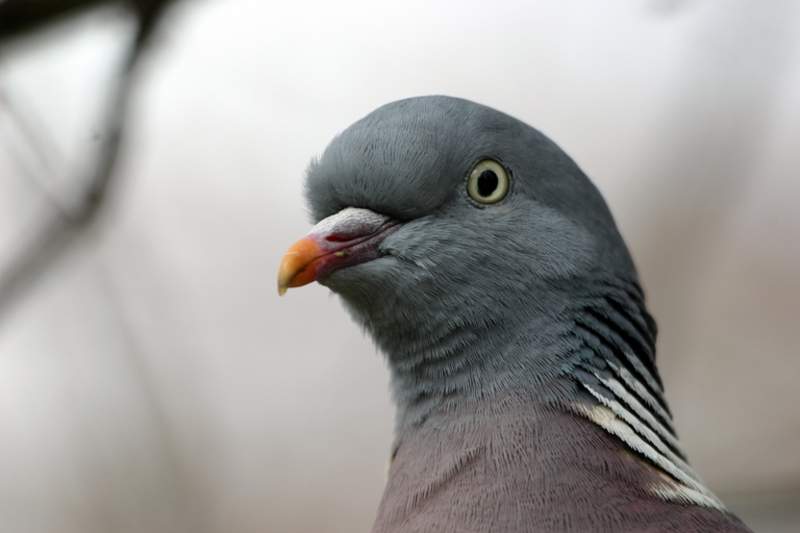
by Pigeon Patrol | Oct 26, 2020 | Bird Deterrent Products, Bird Netting, Bird Spikes, Pigeon Control, Pigeon Patrol's Services
Pigeon Family Life
Pigeons and their family live in groups called “flocks.” Each flock has an equal number of male and female members. A courting male pursues his intended mate on the ground, circling her, with his neck feathers inflated and his tail spread, bowing and cooing all the while. Pigeons mate for life, but if one partner dies the survivor generally will attempt to find another mate.
Pigeons show a strong affinity for human-built structures. Nests, a haphazard combination of twigs, leaves, and a few feathers, are built on window ledges, behind signs, and under bridges. Parents take turns incubating the clutch of one or two white, unmarked eggs for between 16 and 19 days. After the eggs hatch, both parents feed the baby pigeons, or squabs, a crop secretion called “pigeon milk,” which is produced from the lining of the crop, a sac-like food storage chamber located under the bird’s esophagus. The milk is a highly nutritious and an efficient way of feeding young. Squabs fledge at four to six weeks of age but remain dependent on their parents for as long as the adults will tolerate them — generally another one or two weeks. Individuals may be capable of breeding at six months of age.
Pigeons leave their nesting and roosting sites during daylight hours to search for food, but they return at night, as well as periodically during the day when raising young.
source
About Pigeon Patrol:
Pigeon Patrol Products & Services is the leading manufacturer and distributor of bird deterrent (control) products in Canada. Pigeon Patrol products have solved pest bird problems in industrial, commercial, and residential settings since 2000, by using safe and humane bird deterrents with only bird and animal friendly solutions. At Pigeon Patrol, we manufacture and offer a variety of bird deterrents, ranging from Ultra-flex Bird Spikes with UV protection, Bird Netting, 4-S Gel and the best Ultrasonic and audible sound devices on the market today.
Contact us at 1- 877– 4– NO-BIRD, (604) 585-9279 or visit our website at www.pigeonpatrol.ca
Bird Gone, Pigeon Gone, Seagull Gone, Pigeon problems, pigeon spikes, 1-877-4NO-BIRD, 4-S Gel, Bird Control, Pigeon Control, bird repellent, Bird Spikes, bird law sonic bird repellent, stainless steel bird spikes, bird spikes Vancouver, Ultra Sonic Bird Control, Bird Netting, Plastic Bird Spikes, Canada bird spike deterrents, Pigeon Pests, B Gone Pigeon, Pigeon Patrol, pigeon family pest controller, pest control operator, Bird law pest control technician, Pigeon Control Products, humane pigeon spikes, pigeon deterrents, type of birds, pigeon traps, Pigeon repellents, Sound & Laser Deterrents, wildlife control, raccoon, skunk, squirrel deterrent, De-Fence Spikes, Dragons Den, Canada bird spikes, Pigeon behavior ,Canada pigeon, pigeon control, pigeon patrol, pigeon. Kill pigeons, crow, starling, Pigeon Habitat,
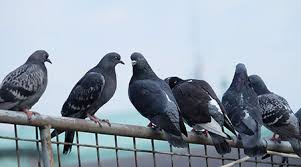
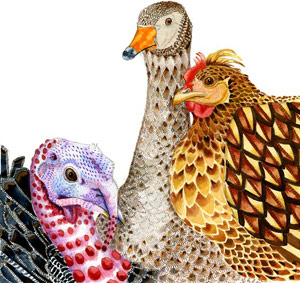
by Pigeon Patrol | Oct 26, 2020 | Bird Deterrent Products, Bird Netting, Pigeon Control, Pigeon Patrol's Services
Guide To Type Of Birds: Maybe it’s due to the fact that birds were a central component of my household for many years (parakeets), but birds are often on my mind. Everyone romanticizes birds because of their ability to fly. Yes, flight is awesome, that’s why we invented the airplane. Bats and bugs fly, but rarely are those animals included on anyone’s list of “animals I’d like to be.” Oh, I wish I were a bird, then I could fly anywhere and be with other birds to peck at millet or something. I’m really happy I’m not a bird. If you were a bird then flying would be normal, and you wouldn’t understand that you were flying because you’d be a stupid bird. The only thing you would think about is probably some form of seed or worm, and its proximity to your beak. The rest of your time would be spent squawking, tweeting, or cawing for extended periods of time about nothing in particular.
Crows are apparently some of the “smartest” birds, which is like being the “most athletic” cripple.This is not meant as an assault on birds; anything but. I’m just laying out the facts as I see them. I love birds. Birds are hilarious. One of my fondest memories of visiting Spain was when I hit this pigeon with a rolled-up newspaper in a courtyard. It was awesome for some reason. Hitting any other animal with a rolled-up newspaper would be much less funny (including a human), but birds have that bit of comedic magic that puts their reactions above and beyond. If you haven’t laughed at a bird before, maybe you should look a little closer. If you still don’t think birds are Earth’s comedic gift to us (along with many other things; Jewish comedy writers mostly), then you should reexamine your sense of humor.
Let’s face it, birds are really stupid. Chickens, turkeys, and ducks are especially stupid for allowing themselves to be bred and murdered by the millions every day, but let us not excuse the less-notably stupid, but still fascinatingly dumb members of the bird kingdom. I think I could break down all groups of birds into a few distinct categories, and this will be the new biologist’s guide to understanding and analyzing birds and their behavior, and general stupidity and ridiculousness.
Group #1: Birds we eat a lot of.
Examples: Chickens, ducks, turkeys, maybe some geese if you’re in 19th century Britain.

These birds are really stupid and extremely funny. One time we put a live chicken in my friend’s room while he was out, and he came back in and freaked out. Just the mere presence of a chicken demands a mirthful response. Look at the greatest comedy props of all time: the whoopie cushion and the rubber chicken. They both appeal to the most primal of human comedic needs. The whoopie cushion is great because it makes a farting sound, and the rubber chicken is great because it looks like a chicken and that’s just funny. Eating chicken is awesome too, and they also lay eggs which I eat a ton of. These two points are not funny, but should be noted to access the chicken’s overall value to human society.
All ducks look partly confused but generally in the moment and satisfied. Ducks seem to need human names like Roger, Stanley, and Ralph. The “quack” is also a very underrated bird noise. In my opinion it sits just above a goose “honk,” and right below a crow’s “caw” on the bird noise hierarchy. Famous ducks include Donald, Daffy, and the Aflac duck.
Turkeys are funny because they are so awkward. I know turkeys in factory farms are pretty messed up, so to appreciate good turkey humor you have to see wild turkeys. They’re kind of scary but at the same time, whatever, they’re stupid turkeys. In English, the word “turkey” is used to describe someone of questionable intelligence and above-average awkwardness. Benjamin Franklin wanted to make this our national bird instead of the bald eagle—one of the many reasons I don’t really like Benjamin Franklin.
Group #2: Birds that hang out near people and annoy them.
Examples: Pigeons, crows, seagulls.
These are perhaps the funniest birds because they’re so annoying and stupid. What’s better than watching a seagull or pigeon swoop in out of nowhere and steal French fries from beachgoers and random middle-aged people? Pigeons are everywhere around the world and they bob their heads when they walk. This is pretty funny. How did pigeons get to so many different places? I think maybe world leaders back in the day got together and had a summit about bringing more generic comedy into cities worldwide. Unanimously they agreed that these stupid birds could bring cultures together better than anything else.
Crows are apparently some of the “smartest” birds, which is like being the “most athletic” cripple. I’d rather be a stupid human than a “smart” bird. Have you ever heard one of those obnoxious crows that just keeps on cawing, and eventually it becomes some bastardized version of the original caw? It starts as your formal CAW CAW before descending into RAW WAW AWWWWWWW. I still remember waking up to the stupidest cawing I’ve ever heard back in eighth grade. Crows are really funny.
Seagulls always steal stuff from people, but it’s fun to throw bottles at them. I love when people get angry at you for hitting a seagull with something when you’re at the beach. People defend seagulls so much until they’re actually robbed by one of these ridiculous creatures. Now there’s a cause to really get behind, save the seagulls.
Group #3: Birds that kill rodents on nature shows.
Examples: Eagles, hawks, owls.
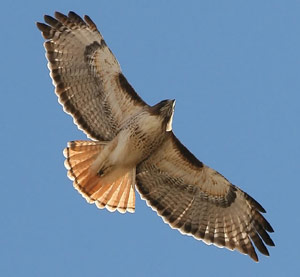
In my opinion, this is the only group of birds that I can consider “badass.” I know there are obvious outliers like certain carnivorous birds in Australia or something, but I really don’t care. I love seeing these birds kill stuff on nature shows, and if I had to make any bird really big so I could saddle it and ride it, it would probably be an eagle. Eagles are the symbol of America, and that’s pretty cool.
Hawks like to fly in circles over random places so people will stop and say, “Oh, look at that hawk! I wonder what he’s flying over?” He’s flying over a bunch of people who care about seeing a hawk fly in circles. Congratulations on feeding a hawk’s ego.
Owls are really wise for birds. I know this because they somehow convinced all fourth graders that it was reasonable to dissect their puke for science class.
Group #4: Big, dumb flightless birds.
Examples: Ostriches, emus, penguins, kiwis, peacocks.
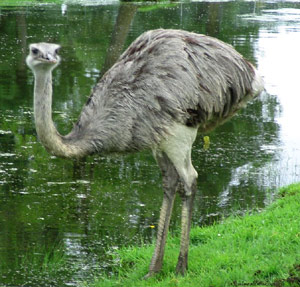
These birds taste better than those in Group 1, but people don’t give them enough credit for that. I’ve never tasted penguin, but I suppose it may be a bit fishy. Either way, ostrich is delicious. These birds could probably mess some stuff up if you left them alone in your apartment. They would probably walk around scratching and pecking at stuff with their awkward bodies until everything broke. I think that’s inconsiderate, but big, dumb, flightless birds don’t know any better.
This group is synonymous with stupidity. Dodo’s were big, dumb flightless birds that eventually became too stupid to live on the island of Mauritius and subsequently rendered themselves extinct. I’ve met a bunch of emus, and each one was really unintelligent. They can barely hold a conversation, let alone begin to write an essay or solve a math problem. Purely idiotic creatures.
Penguins get a lot of credit for mating and living where it’s cold. They’re also acknowledged for sort of looking like they are wearing tuxedos. I would like to see a penguin actually wearing a tuxedo tailored to its proportions. It would have such a difficult time doing anything penguiny, and that would be comedy gold.
Group #5: Pet birds that may be able to talk.
Examples: Cockatiels, parrots, parakeets.
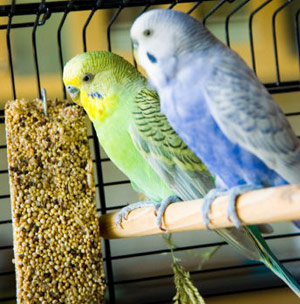
I’ve had a lot of experience with these types of birds. I lived with a number of parakeets for many years. They like to squawk and annoy people who aren’t used to them. They can also smell fear like dogs, and will pester those that find them most repellent.
Parrots have tricked a lot of people into thinking they’re smart because they can speak some English. I don’t buy into the parrot hype. They kind of creep me out. If I wanted to hear words over and over again, I would just say those words over and over. Or, in the true nature of parrots, I would just record my voice and whenever I needed a little dose of language, I would just play the recording. Everyone I know speaks better human language than parrots (this may be because I don’t personally know any infants right now), so maybe stop giving them so much credit and they won’t cost $1,500 at Petco.
Group #6: Birds that people like to see and know the names of, but are generally useless otherwise.
 Examples: Cardinals, robins, goldfinches.
Examples: Cardinals, robins, goldfinches.
These birds are cool because they can make anyone sound like a birdologist at any given moment. “Ooh, look at that cardinal! You know it’s a male because it’s bright red; the females are less brightly colored.” This is a great way to sound smart by regurgitating well-known knowledge as if it were the result of years of consistent bird-study. Robins are good because it’s my mother’s name, as well as the name of Batman’s gayboy sidekick. They also mean spring is here, or something.
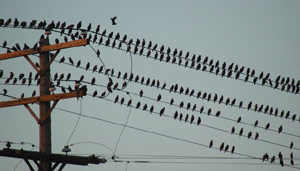
Group #7: All the little black birds that hang out on power lines and no one really cares about.
Examples: Those little black birds that hang out on power lines that I don’t know the names of.
Sometimes a bunch of these things will fly all at once off of a power line. It makes you feel like you’re in a movie where something really epic and scary is about to happen. No large group of birds is better at being ominous and setting the stage for something badass. Other than that, these birds are pretty useless.
Group #8: The peregrine falcon.
Yeah, it gets its own category for some reason.
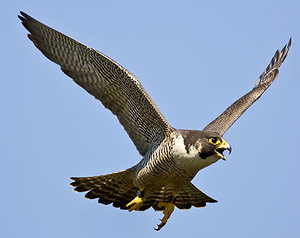
This bird is “the fastest animal in the world,” though here’s another bird fallacy I don’t buy into. Barring humans (the actual fastest animal in the world; we have planes and rocket ships, those are way faster than falcons), I still give the “fastest” card to the cheetah. Peregrine falcons are just sort of plummeting when people test their speed. It’s not like this thing is flapping its way to the record, it’s just falling and flapping simultaneously. Just because it can control itself while falling doesn’t mean it deserves the title. Still, this bird is badass for killing doves in midair and having a really intense and dramatic stare.
So there you have it: the 8 distinct type of birds, meticulously categorized and analyzed for the scientific community. I hope you feel a newfound respect for these hilarious, not-at-all mysterious, omnipresent creatures.
source
About Pigeon Patrol:
Pigeon Patrol Products & Services is the leading manufacturer and distributor of bird deterrent (control) products in Canada. Pigeon Patrol products have solved pest bird problems in industrial, commercial, and residential settings since 2000, by using safe and humane bird deterrents with only bird and animal friendly solutions. At Pigeon Patrol, we manufacture and offer a variety of bird deterrents, ranging from Ultra-flex Bird Spikes with UV protection, Bird Netting, 4-S Gel and the best Ultrasonic and audible sound devices on the market today.
Contact us at 1- 877– 4– NO-BIRD, (604) 585-9279 or visit our website at www.pigeonpatrol.ca
Bird Gone, Pigeon Gone, Seagull Gone, Pigeon problems, pigeon spikes, 1-877-4NO-BIRD, 4-S Gel, Bird Control, Pigeon Control, bird repellent, Bird Spikes, bird law sonic bird repellent, stainless steel bird spikes, bird spikes Vancouver, Ultra Sonic Bird Control, Bird Netting, Plastic Bird Spikes, Canada bird spike deterrents, Pigeon Pests, B Gone Pigeon, Pigeon Patrol, pest controller, pest control operator, Bird law pest control technician, Pigeon Control Products, humane pigeon spikes, pigeon deterrents, type of birds, pigeon traps, Pigeon repellents, Sound & Laser Deterrents, wildlife control, raccoon, skunk, squirrel deterrent, De-Fence Spikes, Dragons Den, Canada bird spikes, Pigeon behavior ,Canada pigeon, pigeon control, pigeon patrol, pigeon. Kill pigeons, crow, starling, Pigeon Habitat,
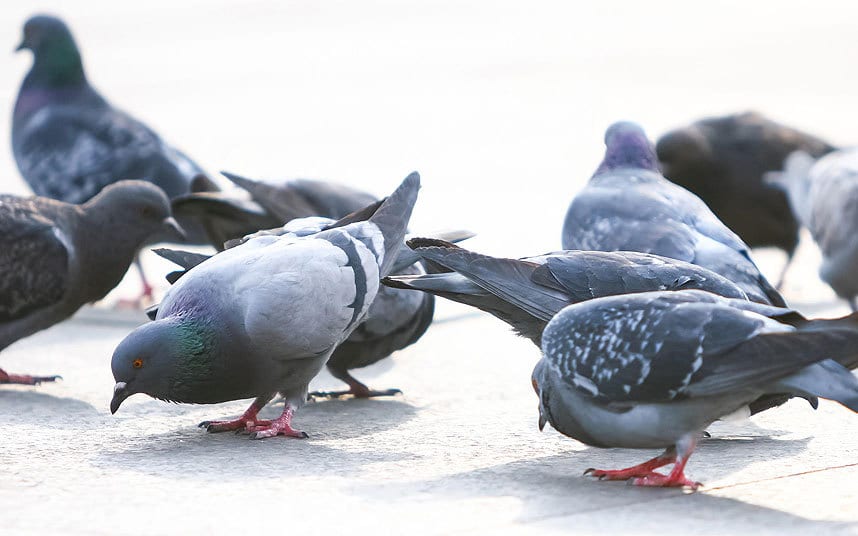
by Pigeon Patrol | Oct 21, 2020 | Animal Deterrent Products, Bird Deterrent Products, Bird Netting, Bird Spikes, Pigeon Patrol's Services, Pigeon Spikes
Pigeon Behavior
Most birds take a sip of water and throw back their heads to let the water trickle down their throats. But pigeons (and all of their relatives in the family Columbidae) suck up water, using their beaks like straws.
Pigeon Behavior: Do pigeons have compasses in their heads? Not really, but pigeons, especially those bred for their homing instincts, seem to be able to detect the Earth’s magnetic fields. Cornell University pigeon researcher Dr. Charles Walcott says that magnetic sensitivity, along with an ability to tell direction by the sun, seems to help pigeons find their ways home.
On the ground, pigeons don’t hop the way many birds do. They walk or run with their heads bobbing back and forth. Pigeons are strong fliers and can fly up to 40 or 50 miles per hour. Some pigeons are raised for their exceptional abilities to fly fast and find their ways home. These pigeons may fly as far as 600 miles in a day. Although feral pigeons are good fliers too, most of these birds seem to stay close to their regular feeding sites.
As gregarious animals, feral pigeons tend to nest in flocks. Once they settle, they tend to nest at the same place for the rest of their lives. Pigeons are extraordinarily intelligent. Even when removed from the nest, they will return back to it. The distance doesn’t play a role—pigeons have “built-in” compasses in their bodies which provide tremendous help with orientation. No matter how far away from their home they are released, they will still find their way back.
Feral pigeons breed rapidly. They lay two eggs, up to six times a year—depending on the food available. If a local population is decreased, pigeons from other areas flock to take advantage of the abundance of food. Thus, poison often causes population boom rather than decrease.

Natural Predators
Man is by far the greatest predator of pigeons. Yet they also have plenty of other predators too including Falcons, Sparrow, hawks, Owls, Foxes, Ferrets, Snakes, Rats, Cats, Dogs and more.
One species of falcon, Merlin, eats so many pigeons its scientific name is Falco columbaries (with the “Columba-” meaning pigeon) and it was formerly called pigeon hawk. Merlin’s are medium-sized falcons and although they are not very common in cities, you can bet they are preying on pigeons living in open parks near marshes and ponds.They are small and quick and they tend to prefer park areas rather than high towers. They hide in trees, or drop down from light posts. The one I saw took his pigeon back up to a tree and the only evidence was a few feathers drifting down occasionally. I only ever saw that once, but I know they are around. I bet you have them too. Another falcon that is a natural predator of the pigeon is the peregrine falcon, a bird that can achieve speeds of up to 200 miles per hour in a dive and one of the few birds that has the speed and the maneuverability to outpace and catch a pigeon in flight. In North America some big cities have wild Peregrine Falcons. These falcons like to nest on high cliffs, and city high rises work too. There is a famous pair in San Francisco, for example. Whenever these birds find a ledge to nest on, the Eagle-cam team is usually not far behind.

Source
About Pigeon Patrol:
Pigeon Patrol Products & Services is the leading manufacturer and distributor of bird deterrent (control) products in Canada. Pigeon Patrol products have solved pest bird problems in industrial, commercial, and residential settings since 2000, by using safe and humane bird deterrents with only bird and animal friendly solutions. At Pigeon Patrol, we manufacture and offer a variety of bird deterrents, ranging from Ultra-flex Bird Spikes with UV protection, Bird Netting, 4-S Gel and the best Ultrasonic and audible sound devices on the market today.
Contact us at 1- 877– 4– NO-BIRD, (604) 585-9279 or visit our website at www.pigeonpatrol.ca
Bird Gone, Pigeon Gone, Seagull Gone, Pigeon problems, pigeon spikes, 1-877-4NO-BIRD, 4-S Gel, Bird Control, Pigeon Control, bird repellent, Bird Spikes, bird law sonic bird repellent, stainless steel bird spikes, bird spikes Vancouver, Ultra Sonic Bird Control, Bird Netting, Plastic Bird Spikes, Canada bird spike deterrents, Pigeon Pests, B Gone Pigeon, Pigeon Patrol, pest controller, pest control operator, Bird law pest control technician, Pigeon Control Products, humane pigeon spikes, pigeon deterrents, pigeon traps, Pigeon repellents, Sound & Laser Deterrents, wildlife control, raccoon, skunk, squirrel deterrent, De-Fence Spikes, Dragons Den, Canada bird spikes, Pigeon behavior ,Canada pigeon, pigeon control, pigeon patrol, pigeon. Kill pigeons, crow, starling, Pigeon Habitat,

by Pigeon Patrol | Oct 20, 2020 | Bird Deterrent Products, Pigeon Control
Budget Friendly Pigeon Deterrents
Looking to try more pigeon deterrents to see which one works best for you? First off, Pigeons have excellent eyesight & are startled by unexpected visual signals or recognizable predators. Here are 3 budget friendly bird deterrent products that could help you keep these pests and other birds such as sparrows, and crows away from your property
1) Magnetic Bird Defender
Thanks to technological innovations, you can find several kinds of equipment to scare birds away. One is you can use this powerful magnet to repel the birds. This magnet is flashy and interferes with the birds’ sense of direction and confuses them which will cause them to stay away from the radius of the magnet’s field. The number of magnets or their strength will depend on the size of your property. Pigeons and other birds tend not to approach any area where there is a magnetic field stronger than the terrestrial magnetic field. You can hang these on your balcony, porch, front door, wherever these pests may be
Get your magnetic bird defender here https://www.pigeonpatrol.ca/product/magnetic-bird-defender/

Source
2) Reflective Owl Repellent
These owl repellents are budget friendly and effectively scares birds away because of the reflective print. The pigeon’s eye is one-half the weight of its brain, whereas man’s eye is only one-fiftieth of his brain weight. Pigeons have a very wide visual field of around 340° compared to the 180°of humans. So when they come across these reflective owls, there eyes get irritated and they can’t stand it. Another reason why these owls are effective is simple: Owls prey on pigeons and pigeons are not the smartest things on wings. Confronted with something that looks like an owl, a pigeon will assume the worst and fly away. The ruse is hardly new. For years, gardeners and boaters have used fake owls to scare off birds. This owl-shaped surface contains hundreds of three-dimensional light-refraction spots. When the sunshine comes to this surface, it is immediately reflected in various rays of colors. Additionally, each decoy is attached with two hawk bells, and these will unpredictably emit sounds to startle the birds
CALL US TO ORDER THESE REFLECTIVE OWLS (604) 585-9279

3) Reflective Ribbons
One of the classic and primary tools is the bird repellent tape, This is another bird control applying the refractive holographic technique on both sides. This tape is about 5 centimeters width and nearly 100 meters long, which is enough to cover my backyard. It does not consume much of my time and effort to hang up the tapes. I cut them into strips about 40 centimeters long, and stick them to the wall with layers of adhesive tapes, or tight with thin rope, dental floss, any kind of thin string appearing in my kitchen. Or I sometimes cut them into approximately one-meter strips and tight upon the tree branches. Actually, it is not compulsory to hang on the highest spots, but scare tape should be directly contacted with sun rays and wind so that they could flail wildly to create flashing light and flapping sound.
CALL US TO ORDER THESE REFLECTIVE TAPES (604) 585-9279
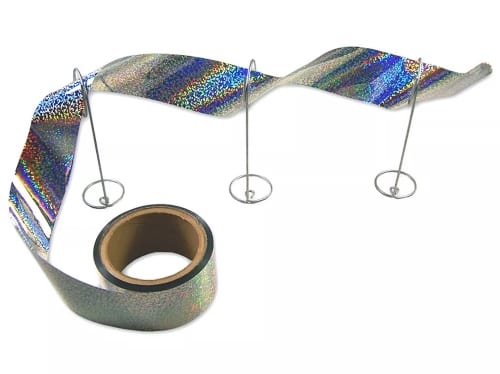
With visual deterrents, surprise & change are vital. Birds quickly acclimate to static scares, so we don’t sell them. Pigeon Patrol has these visual products that contain some element of change or movement, making them more effective than the stationary units offered in the marketplace. For large areas, use more visuals — either the same type or a variety. Change the location of your visual deterrents from time to time to maintain its effectiveness in keeping away the bird pests.
About Pigeon Patrol:
Pigeon Patrol Products & Services is the leading manufacturer and distributor of bird deterrent (control) products in Canada. Pigeon Patrol products have solved pest bird problems in industrial, commercial, and residential settings since 2000, by using safe and humane bird deterrents with only bird and animal friendly solutions. At Pigeon Patrol, we manufacture and offer a variety of bird deterrents, ranging from Ultra-flex Bird Spikes with UV protection, Bird Netting, 4-S Gel and the best Ultrasonic and audible sound devices on the market today.
Contact us at 1- 877– 4– NO-BIRD, (604) 585-9279 or visit our website at www.pigeonpatrol.ca
Bird Gone, Pigeon Gone, Seagull Gone, Pigeon problems, pigeon spikes, 1-877-4NO-BIRD, 4-S Gel, Bird Control, Pigeon Control, bird repellent, Bird Spikes, sonic bird repellent, stainless steel bird spikes, bird spikes Vancouver, Ultra Sonic Bird Control, Bird Netting, Plastic Bird Spikes, Canada bird spike deterrents, Pigeon Pests, B Gone Pigeon, Pigeon Patrol, pest controller, pest control operator, pest control technician, Pigeon Control Products, humane pigeon spikes, pigeon deterrents, pigeon traps, Pigeon repellents, Sound & Laser Deterrents, wildlife control, raccoon, skunk, squirrel deterrent, PIGEON DETERRENTS, De-Fence Spikes, Dragons Den, Canada bird spikes, Canada pigeon, pigeon control, pidgon patrol, pigeon. Kill pigeons, crow, starling, Pigeon Habitat

by Pigeon Patrol | Oct 20, 2020 | Bird Deterrent Products, Bird Netting, Bird Spikes, Pigeon Droppings, Pigeon Spikes
Danger of Pigeon Droppings
Although pigeons themselves are not considered to be a danger to humans, their droppings is a different story. Pigeons transmit diseases through their droppings and can easily affect someone with a weakened immune system if near by.
Pigeon droppings that are infected with bacteria or viruses are often left on the street, windowsills and cars to dry out. Once they do, they become a powder, which is blown or kicked into the air and then inhaled. The inhalation of this powder is one way that the pathogens that can cause disease can be spread to us.
Pathogens
According to Medical News Today, the most common pathogens which can cause disease transmitted from pigeons to humans are:
- E. coli. This occurs when bird droppings land in a water or food supply and are then consumed by humans. This can typically be avoided by washing food thoroughly before eating. Symptoms include nausea, fever and cramps.
- St. Louis encephalitis.This disease is spread by mosquitoes after they feed on a bird that carries the pathogen that spreads St. Louis encephalitis. This inflammation of the nervous system is dangerous to all age groups, but can be particularly dangerous and even fatal in adults over 60 years old. Symptoms include drowsiness, headache and fever.
- Histoplasmosis.This respiratory disease occurs as a result of a fungus growing in pigeon droppings and can be fatal.
- Candidiasis.This disease is also a respiratory condition caused by a fungus or yeast found in droppings. The areas affected include skin, mouth, the respiratory system, intestines and the urogenital tract, particularly in women.
- Salmonellosis.This disease is commonly called “food poisoning” and spreads via infected droppings turning into dust and contaminating food and food preparation surfaces prior to consumption.
Pigeons are also carriers of mites, fleas, and West Nile virus, and all of which can cause discomfort and potentially serious health issues in humans.
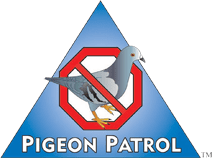
If you are cleaning up or come into contact with droppings, you should take precautions. Wash your hands and clean any exposed skin before eating, drinking or putting your hands near your mouth. Likewise, if you are feeding or handling birds, wash your hands afterwards. If you have a compromised immune system, including from HIV/AIDS or cancer, you should not clean up droppings.
Destroys Cleanliness of Property
Pigeon droppings are unsightly and can cause problems by making pavements and steps slippery, particularly in wet weather. Droppings can also corrode stonework and damage buildings. Nesting material, droppings and dead birds may block gutters and drains leading to water damage to buildings. Pigeon droppings are quite high in uric acid, which corrodes car exteriors like no one’s business. With an average pH of about 3, dried bird poop will peel away clearcoats, bleach paint, and leave cartoonish etchings of itself even after a car wash.
Pigeon droppings can cause severe damage to not just your roof but also other parts of your house. Some of the havoc birds poop can cause to your roof include:
Uric Acid
Bird poop contains uric acid, which can damage your roof. Since birds don’t urinate, the only way they could get rid of nitrogenous waste from their body system is through their poop. The acidic content of the white liquid can wreak havoc on materials like concrete, car paint, and roofing materials. The most vulnerable roof material to uric acid is the asphalt shingles.
Effect on Solar Panel
Roof-mounted solar panels have become a modern haven for pigeons and other bird species. This is so because solar panels provide warmth and shelter from the wind and rain. More so, it is a perfect spot for nesting, which ultimately results in massive bird dropping problems. Apart from the fact that these birds cause damage to the solar panel wiring, they also create a mess by leaving their droppings on top of them. These droppings, if left to sit for an extended period of time , blight solar panels and can render the system useless.
Blocked Gutters
Pigeons picking on dried poop for bugs can drop these waste into your gutters. These bird droppings contain seeds that may likely create additional problems for your drainage system. When a bird poop is left for long on your roof, wind or rain may eventually wash the bird poop and seeds into the gutters. These seeds can grow into weeds and shrubs in the gutter given the right conditions, thus affecting the flow of water. A clogged gutter will eventually lead to roof leakages. So make sure you clean your gutters regularly to ensure that they are free of debris and other waste products left by pigeons.
Moss Growth
Moss thrives in shady, damp places and are commonly found on the roof. Failure to tackle moss growth heads on can result in water leaks and damage. In addition, it can clog your drainage and gutters. Moss retains moisture, and this could further hamper the efficiency of your roof materials. What is for certain is that if birds and pigeons regularly leave droppings on your roof, the moss problem can be difficult and more expensive to contain. The nutrients from pigeon poop stimulate moss growth. More reasons why you need to get rid of pigeons and bird pests from your roof.
Bird Laws
Some laws protect native birds. So you need to follow laid down protocols when getting rid of them. Some of the legal methods of preventing birds nesting on your roof include roof spikes and bird deflectors. If you don’t want to face the wrath of the law, then make sure you contact reputable bird control service for assistance. Read More About Bird Laws Here
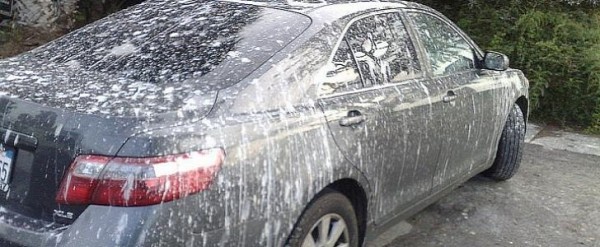
Source
About Pigeon Patrol:
Pigeon Patrol Products & Services is the leading manufacturer and distributor of bird deterrent (control) products in Canada. Pigeon Patrol products have solved pest bird problems in industrial, commercial, and residential settings since 2000, by using safe and humane bird deterrents with only bird and animal friendly solutions. At Pigeon Patrol, we manufacture and offer a variety of bird deterrents, ranging from Ultra-flex Bird Spikes with UV protection, Bird Netting, 4-S Gel and the best Ultrasonic and audible sound devices on the market today
Contact us at 1- 877– 4– NO-BIRD, (604) 585-9279 or visit our website at www.pigeonpatrol.
Bird Gone, Pigeon Gone, Seagull Gone, Pigeon problems, pigeon spikes, 1-877-4NO-BIRD, 4-S Gel, Bird Control, Pigeon Control, bird repellent, Bird Spikes, sonic bird repellent, stainless steel bird spikes, bird spikes Vancouver, Ultra Sonic Bird Control, Bird Netting, Plastic Bird Spikes, Canada bird spike deterrents, Pigeon Pests, B Gone Pigeon, Pigeon Patrol, pest controller, pest control operator, pest control technician, Pigeon Control Products, humane pigeon spikes, pigeon deterrents, pigeon traps, Pigeon repellents, Sound & Laser Deterrents, wildlife control, raccoon, skunk, squirrel deterrent, De-Fence Spikes, Dragons Den, Canada bird spikes, Canada pigeon, pigeon control, pidgon patrol, pigeon. Kill pigeons, crow, starling, Pigeon Habitat, Danger of Pigeon
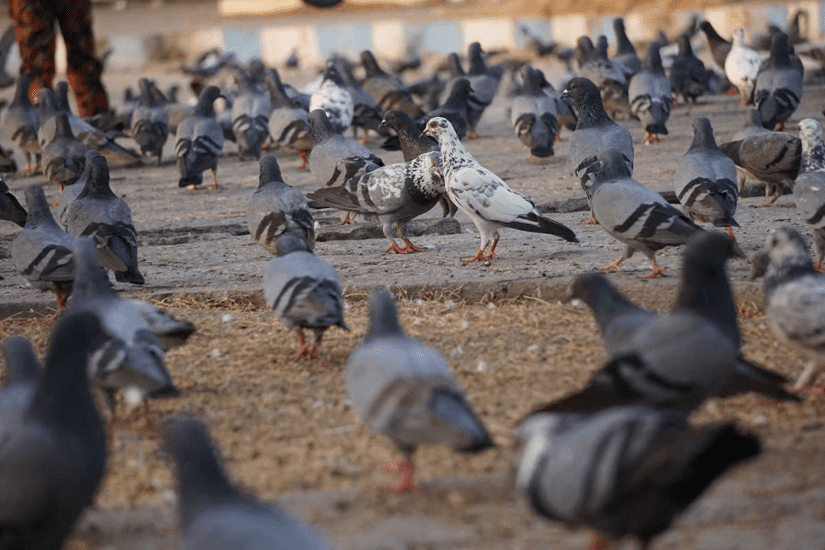
by Pigeon Patrol | Jun 29, 2020 | 4-S Gel Bird repellent, Animal Deterrent Products, Bird Deterrent Products, Bird Netting, Bird Spike, Bird Spikes, Pigeon Control, Pigeon Droppings, Pigeon Patrol's Services, Pigeon Spikes, Pigeons in the News, UltraSonic Bird Control
Pigeon Habitat. Pigeons prefer grains for food and people will commonly feed pigeons unintentionally by spilling food or it in open trash containers. Pigeons roost in areas above ground and will readily nest in steeples, as well as voids on outside areas of buildings and other protected areas.
Pigeons are dependent on humans to provide them with food, roosting and nesting sites. They are commonly found around agricultural areas as well as warehouses, feed mills, and grain elevators. They are also commonly found in cities around parks, buildings, bridges, and any other structures.
Source
About Pigeon Patrol:
Pigeon Patrol Products & Services is the leading manufacturer and distributor of bird deterrent (control) products in Canada. Pigeon Patrol products have solved pest bird problems in industrial, commercial, and residential settings since 2000, by using safe and humane bird deterrents with only bird and animal friendly solutions. At Pigeon Patrol, we manufacture and offer a variety of bird deterrents, ranging from Ultra-flex Bird Spikes with UV protection, Bird Netting, 4-S Gel and the best Ultrasonic and audible sound devices on the market today.
Contact us at 1- 877– 4– NO-BIRD, (604) 585-9279 or visit our website at www.pigeonpatrol.ca
Bird Gone, Pigeon Gone, Seagull Gone, Pigeon problems, pigeon spikes, 1-877-4NO-BIRD, 4-S Gel, Bird Control, Pigeon Control, bird repellent, Bird Spikes, sonic bird repellent, stainless steel bird spikes, bird spikes Vancouver, Ultra Sonic Bird Control, Bird Netting, Plastic Bird Spikes, Canada bird spike deterrents, Pigeon Pests, B Gone Pigeon, Pigeon Patrol, pest controller, pest control operator, pest control technician, Pigeon Control Products, humane pigeon spikes, pigeon deterrents, pigeon traps, Pigeon repellents, Sound & Laser Deterrents, wildlife control, raccoon, skunk, squirrel deterrent, De-Fence Spikes, Dragons Den, Canada bird spikes, Canada pigeon, pigeon control, pidgon patrol, pigeon. Kill pigeons, crow, starling, Pigeon Habitat


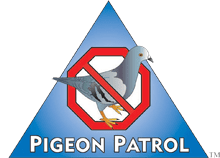




 Examples: Cardinals, robins, goldfinches.
Examples: Cardinals, robins, goldfinches.











